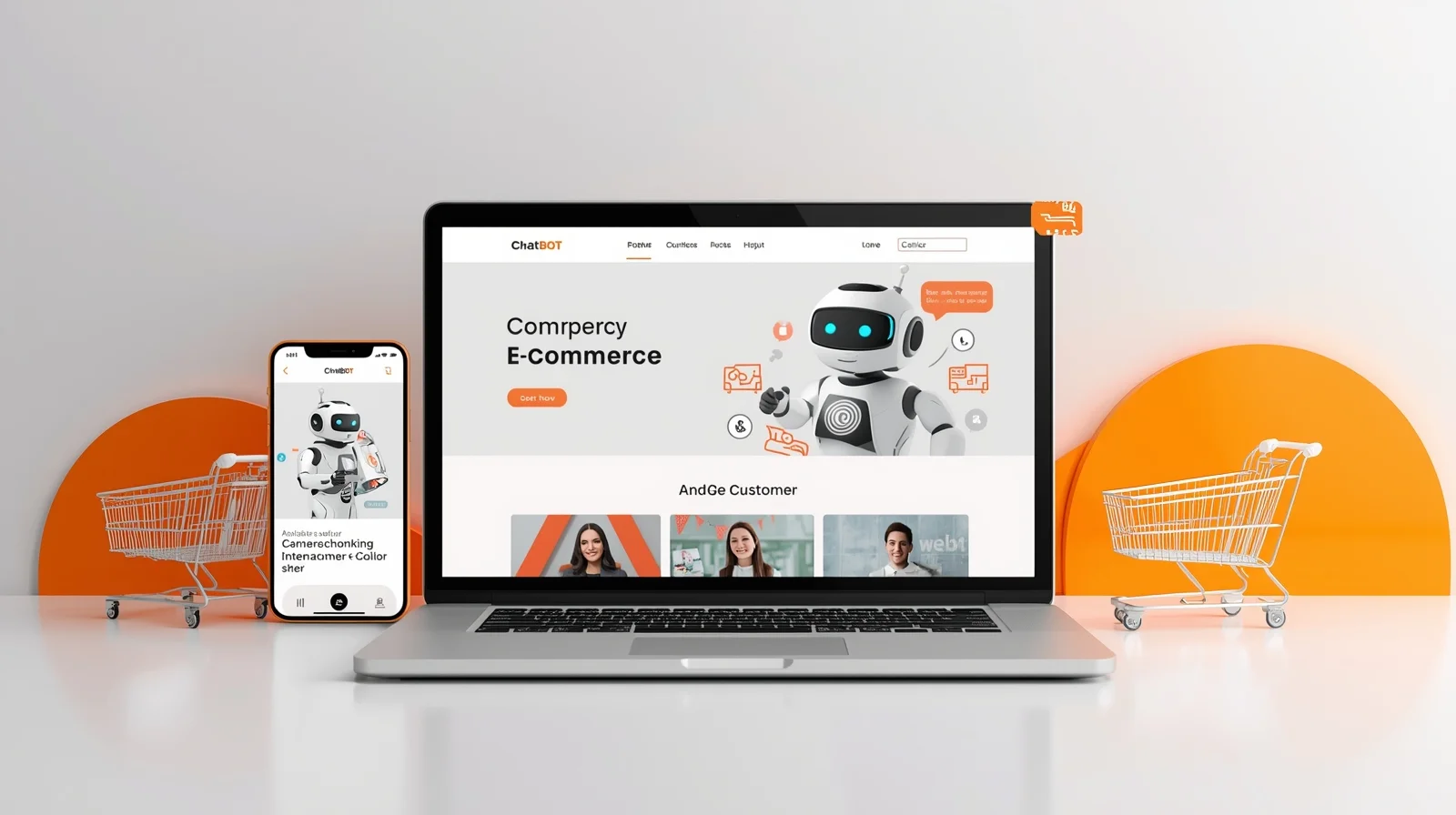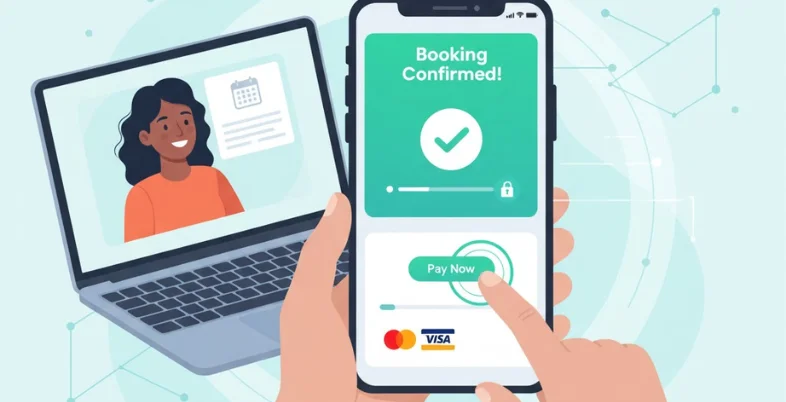In today’s online shopping world, having an instant virtual assistant on your website or social media can make all the difference. That’s where e‑commerce chatbots come in – they answer customer questions 24/7, guide shoppers to products, and even nudge them to complete purchases. For a marketing beginner or small business owner, selecting the right chatbot-building tool can be daunting, given the numerous features and buzzwords available.
The good news is that modern no-code chatbot platforms make it easy to create helpful bots without any programming. In this listicle, we’ll explore five of the best chatbot builders for e‑commerce, highlighting what makes each one unique and beginner-friendly.
List of Top Chatbot Tools for E-commerce
1. SendPulse
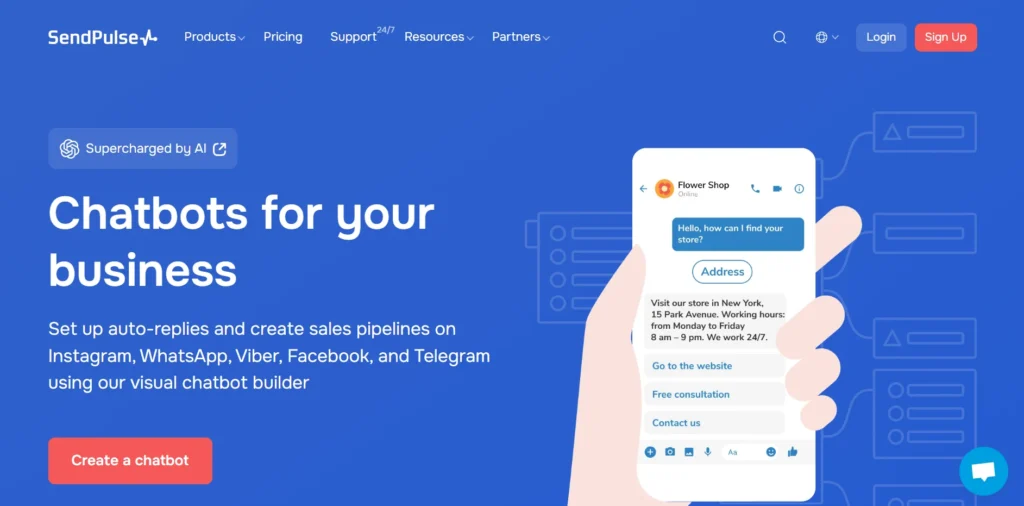
SendPulse is an all-in-one marketing platform that shines as a chatbot builder for e‑commerce. It offers an extremely beginner-friendly experience, with an intuitive drag-and-drop editor and plenty of pre-built templates to jumpstart your chatbot. SendPulse’s free plan is generous – you can build up to 3 chatbots and engage 500 subscribers with up to 10,000 messages per month.
That means a small online shop can start automating customer interactions without spending a dime. This platform is designed to help businesses boost sales via messaging: you can set up auto-replies for FAQs, send 24/7 support messages, and even showcase product catalogs right inside the chat. Overall, SendPulse is a multichannel powerhouse – perfect for beginners who want one solution to handle everything from website chats to social media messaging.
Key Features for E-commerce: What makes SendPulse especially attractive for online sellers is its rich set of e‑commerce features. It supports all the major messaging channels your customers use. You can deploy chatbots on your website (using a customizable chat widget) and integrate with popular social and messaging apps – including Facebook Messenger, Instagram DMs, WhatsApp, and even Telegram and Viber. Notably, SendPulse is an official WhatsApp Business API provider, so you can connect your business’s WhatsApp number directly and run chatbots and campaigns on WhatsApp confidently.
The platform stands out for letting you automatically respond to Instagram comments and story mentions as well – a great way to engage shoppers who comment on your posts. In Messenger and Instagram, your SendPulse bot can use rich visual elements like quick-reply buttons, carousels, and product cards, making the conversation interactive and shopping-friendly.
Advanced Marketing Automation: You can segment your audience using tags and attributes (from demographics or behavior) and set up broadcasts that comply with each channel’s policies. For example, you can broadcast a Messenger update only to users who interacted in the last 24 hours, or send a WhatsApp message to all subscribers using an approved template. The platform also supports event-based triggers that are gold for e‑commerce: you can automatically trigger a chatbot flow when someone adds an item to their cart, makes a purchase, or even just visits a certain page on your site.
One huge win is built-in abandoned cart recovery – if a shopper leaves items without checking out, SendPulse can automatically follow up via email, Facebook/Instagram message, or WhatsApp to gently remind them (and maybe offer a discount). These kinds of automated nudges can really boost your conversion rates by re-engaging would-be customers.
E-commerce Catalog and Payments: To make the shopping experience seamless, SendPulse lets you integrate your product catalog into chat conversations. For instance, in WhatsApp, you can connect your Facebook Commerce Manager catalog and have the bot send product cards with images, prices, and descriptions for items. On Messenger or Instagram, you can use carousel templates to showcase products in a swipeable gallery. This means your chatbot can function almost like a salesperson – showing off products and even helping with orders.
You can set up quick “Buy now” buttons or refer customers to your site’s checkout, and even generate Ref links or QR codes that, when clicked or scanned, open directly into your chatbot (e.g. a QR code at a farmers’ market that opens your WhatsApp bot so the customer can quickly order online). All these features help bridge the gap between casual browsing and actual purchases.
Ease of Use and Support: Despite its powerful capabilities, SendPulse remains friendly for beginners. The visual flow builder is drag-and-drop, letting you create conversation paths with blocks for messages, user input, actions, and conditions. You can design complex flows with branching logic (if the user’s answer is X, go down path Y) and even loop or reuse flows, all without coding. If you’re new to chatbots, SendPulse provides a library of pre-designed templates to get you started quickly. And because SendPulse is a broader marketing platform, you also have access to their email campaign tool, CRM features, and more in one dashboard.
2. Tidio
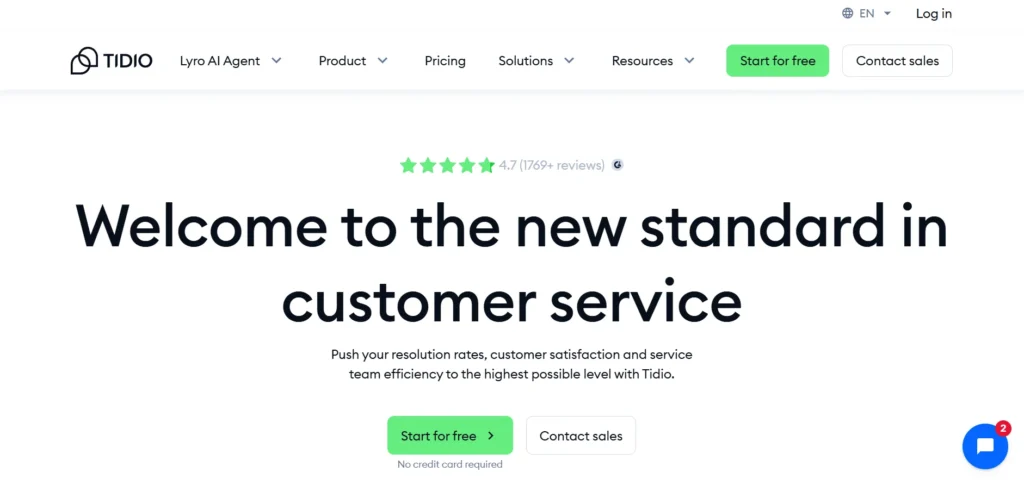
Tidio is an all-in-one customer communication platform that blends live chat with AI chatbots. It offers a modern chat widget for your website and a unified inbox to manage conversations from different channels. Tidio has a free plan, which includes basic chatbot and live chat capabilities. On the free tier, you can chat with up to 50 live visitors per month and have your chatbot engage with 100 unique visitors. Tidio’s focus is largely on customer service automation – think answering FAQs, providing order updates, and helping shoppers navigate – but it also has some marketing tools like email integration for follow-ups.
Key Features for E-commerce: Tidio excels in website chatbots and real-time engagement. You can easily embed Tidio’s chat widget on your site, which allows customers to start a conversation from any page. Through this widget (and Tidio’s backend), you can connect multiple channels: for example, you can manage Facebook Messenger conversations and even Instagram direct messages from the Tidio interface.
For Instagram, while you can respond to DMs through Tidio, note that automated comment replies on posts aren’t a built-in feature – the platform’s Instagram support is more focused on direct messaging and consolidating your inbox. On the WhatsApp front, Tidio offers an integration that lets you connect your WhatsApp Business account, so you can receive and reply to WhatsApp messages in the same dashboard as other chats.
Conversational Shopping & Triggers: Its chatbot builder comes with predefined triggers tailored for e‑commerce. For instance, you can set a chatbot to automatically greet visitors who land on a product page (“Need help with sizing or details?”) or to pop up an offer when a customer’s cart value crosses a certain amount. Tidio provides over a dozen triggers like these – including detecting when a customer adds something to their cart or is about to exit your site – which you can use to start a conversation. The abandoned cart trigger is especially useful: if you integrate Tidio with your store (such as via the Tidio Shopify app), the chatbot can message a user who left items in the cart.
Growth Tools and Limitations: Tidio has excellent features for collecting feedback and engaging customers during or after chats. For example, it can automatically ask users to rate their experience with a quick survey or emoji reaction once a chat ends – giving you valuable insights and testimonials. You can also set up chatbots to ask for product reviews or send “Did you find everything okay?” messages, which encourages user-generated content and feedback.
Another plus is segmentation: Tidio lets you tag and segment users based on their behavior or responses, which can be leveraged in targeted email campaigns or chatbot flows later. Limitations: Tidio is not a broadcast messaging platform for social channels – unlike some dedicated Messenger bot tools, it doesn’t really allow blasting out mass messages on Messenger or WhatsApp. Also, Tidio doesn’t provide built-in tools for things like Messenger ref URLs or QR codes for bot opt-in; it’s assumed you’ll get traffic into the chat via your website or standard channel links.
Ease of Use: It features a simple drag-and-drop interface, allowing you to connect nodes representing triggers (such as “visitor opened chat” or “clicked button”) to actions (like “send message” or “add tag”). Setting up a basic Q&A or lead capture bot is often as easy as editing a template and activating it. Overall, Tidio offers a balanced package: live chat for human touch, chatbots (both rule-based and AI) for automation, and just enough e‑commerce integration (like Shopify triggers and product recommendations) to help increase sales without overwhelming a newcomer.
3. User.com
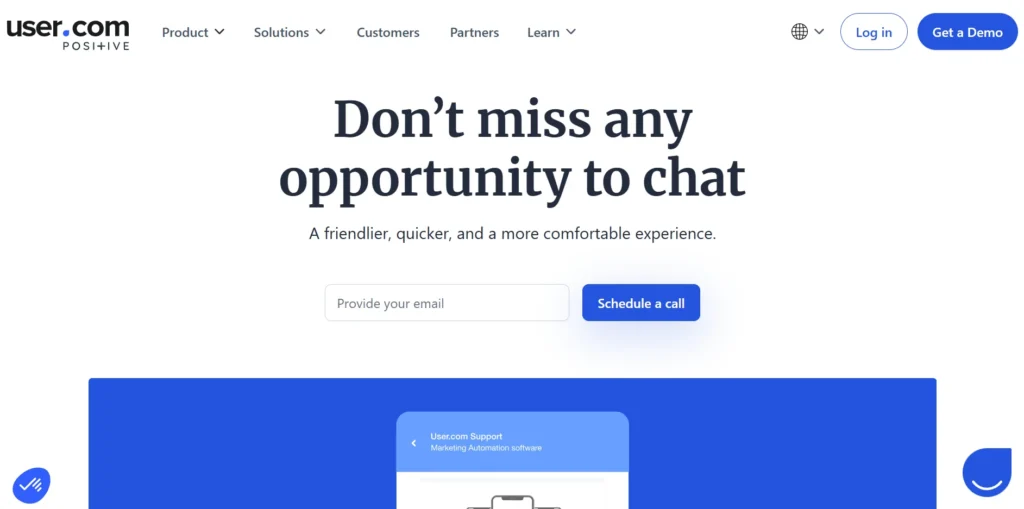
User.com isn’t just a chatbot builder – it’s a unified marketing automation and CRM platform that happens to include live chat and chatbots. For a beginner, User.com can initially feel like a big step up in complexity compared to more chatbot-focused tools, but it pays off if you need a wide range of capabilities under one roof. The platform offers a 14-day free trial for its full feature set. User.com’s philosophy is all about connecting the dots: you can track what users do on your website or in your app, store that data in a CRM contact profile, and then reach out via automated messages on various channels – all based on user behavior.
Key Features for E-commerce: It has a fully customizable website chat widget that supports both live chat and automated bots. The chatbot you create in User.com can handle common questions or qualify leads before a human takes over. When it comes to channels, User.com is pretty comprehensive: it supports email and SMS natively, and also integrates with Facebook Messenger and WhatsApp for messaging. (Instagram is notably absent as a direct integration, so you wouldn’t use User.com for Instagram DMs or comments at this time.) With Messenger, you can connect your Facebook page and have the platform capture those conversations into the CRM, even setting up basic bot replies if desired.
For WhatsApp, User.com provides an official API integration – meaning you can send and receive WhatsApp messages through your User.com workflows (though WhatsApp messaging may require an appropriate business API account and possibly additional fees).
Marketing Automation & Segmentation: You can segment customers based on nearly anything – pages viewed, products added to cart, past purchases, etc. These segments update automatically as user data changes, so you could have a segment like “Viewed Product X but not purchased,” and it will always have the latest people who fit that criterion. You can use those segments to launch targeted campaigns.
Setting up these automations is done through a visual workflow builder that’s quite powerful. It’s like flowcharting your customer journey. For e‑commerce, you can integrate User.com with your store so that events like “Cart Abandoned” or “Order Placed” are tracked.
CRM and Data Power: User.com includes a full CRM. Every person who interacts with your chatbot or website can become a contact with a timeline of their actions and attributes. For a beginner, this might sound advanced, but it’s incredibly useful once you start growing your customer base.
The CRM also helps when human agents need to step in: if you or a teammate answers a live chat, you’ll immediately see that user’s past interactions, orders, etc., enabling more informed and personal communication. While it’s not primarily a Messenger marketing tool, you could use it to send WhatsApp template messages or SMS blasts to specific customer segments.
Considerations for Beginners: The interface is clean, but with so many features, you may need to invest some time in learning how to create workflows or set up tracking. The chatbot builder itself is part of this larger automation builder, which means it’s very flexible: you can insert chatbot actions alongside other marketing actions. As a beginner, you can start small – maybe use the live chat and a simple FAQ bot – and gradually layer on more automation as you get comfortable.
4. Botsify
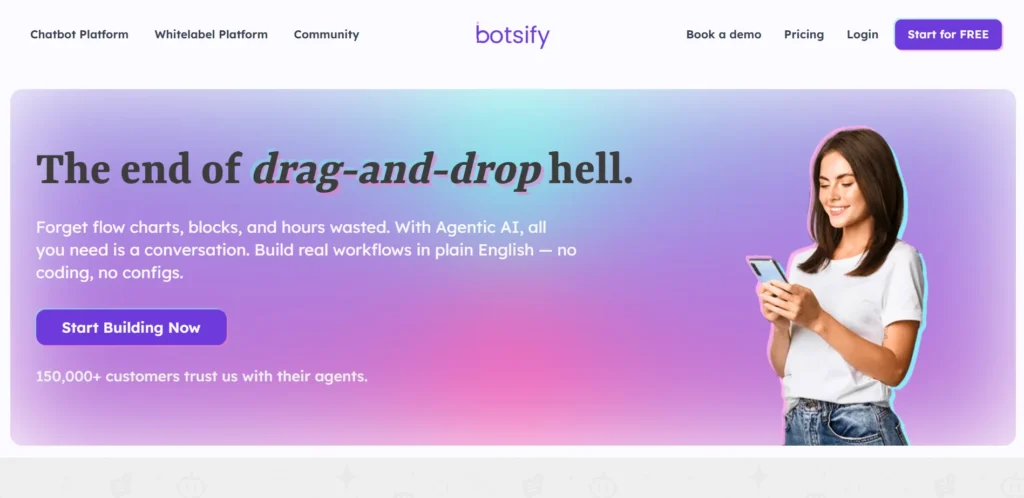
Botsify is a long-standing chatbot platform that emphasizes ease of use and omnichannel deployment. For newcomers to e-commerce marketing, Botsify offers a quick way to get a chatbot running on your website or messaging apps without coding. It’s especially known for helping businesses automate customer support and FAQs, but it also supports lead generation and sales assistance use cases. Botsify offers a 14-day free trial, but after that, it’s a paid service – starting at around $19/month for a basic plan suited to small businesses. Botsify’s approach combines traditional rule-based chatbots with new AI capabilities.
Key Features for E-commerce: You can create chatbots for your website, Facebook Messenger, Instagram, and WhatsApp, as well as other channels like Telegram or even SMS. For Instagram, Botsify’s platform can not only handle direct messages but also automate responses to comments on your posts. This means if someone comments “I love these shoes!” on your Instagram photo, your bot could automatically reply or send them a DM with more info, which is a neat tool for engagement. Botsify provides a chat widget where the bot can greet visitors, answer questions, or collect leads.
Lead Generation and Engagement: The platform enables you to create custom conversational forms, where the bot asks questions one by one. This interactive format often yields better responses than a static form. All the data can be saved to Botsify’s “People” section, which is like a mini-CRM of your leads and users. You can segment users here with tags or attributes, which then lets you send targeted follow-ups.
Speaking of follow-ups, Botsify supports broadcast messaging to your bot subscribers, particularly on Messenger and WhatsApp. Botsify simplifies this by allowing you to select the type of broadcast (update, promotional, etc.), ensuring you stay compliant. For WhatsApp, because it’s an API, Botsify would have you use pre-approved template messages to broadcast – but it does facilitate that process as well.
Automation Capabilities and Limits: You can set up keyword triggers, as well as button triggers. You can also schedule certain messages or connect to external apps via integration tools like Zapier for more complex triggers. However, Botsify doesn’t natively have deep e‑commerce event triggers like “cart abandonment detection” or direct Shopify integration for order status – those would require custom work (possibly using webhooks or APIs if you’re tech-savvy, or using Zapier to catch those events from Shopify and then tell Botsify to respond).
Similarly, features like showing a product catalog from your store inventory aren’t plug-and-play in Botsify; you’d manually set up product info within the bot or connect an API. Abandoned cart recovery, as a built-in sequence, is not a checkbox feature here – you could mimic it by integrating with your store’s cart events, but it’s not as out-of-the-box as some specialized e‑commerce chatbot tools.
Ease of Use and Support: Botsify was designed with non-tech users in mind. The interface allows drag-and-drop arrangement and connecting user responses to the next message, which is pretty intuitive. If you’ve never built a chatbot, Botsify’s interface will feel welcoming – and they also have a bunch of templates for common use cases that you can import and tweak. One thing to note is that Botsify, as a company, has been evolving towards more AI-driven bots recently. This means they are introducing features where you can simply input a chunk of content, and an AI will try to answer user questions based on that, rather than you manually scripting every Q&A.
5. Chatbase
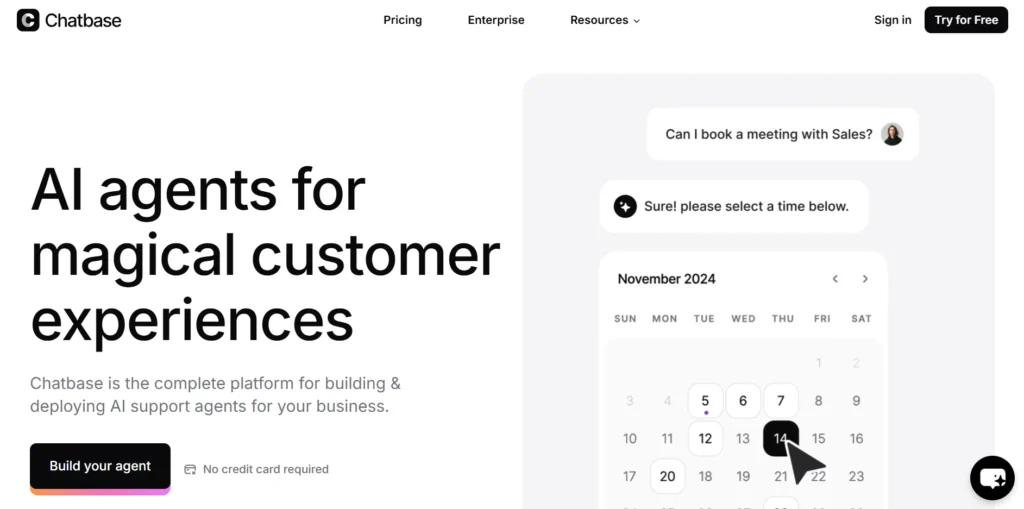
Chatbase lets you create an AI chatbot by simply training it on information you provide (like your website content, PDFs, knowledge base articles, etc.). For an e‑commerce site, Chatbase can be a game-changer in the customer support realm: you can upload your product FAQs, return policy, and other docs, and the chatbot will use that to answer customer queries in a natural way. It’s extremely easy to set up – no coding or flowchart design needed – which is perfect for beginners.
You just provide the content and adjust a few settings. Chatbase offers a free plan: you can have 1 chatbot with up to 100 messages per month. If you find value and need more, their paid plans scale up (for example, the Hobby plan at $40/month gives 2,000 messages, etc.). Chatbase’s chatbots primarily live on your website or mobile app, rather than in Messenger or WhatsApp.
Key Features for E-commerce: Chatbase’s main draw for e‑commerce is intelligent customer support and product guidance. Once your Chatbase bot is trained on your chosen data, it can answer a wide range of customer questions. Customers don’t have to phrase questions exactly a certain way – the bot can understand natural language variations. You can embed the Chatbase chatbot on your website easily (usually via a widget script). Some businesses also integrate Chatbase with other platforms by using its API – for example, connecting it to a Slack channel or a custom chat app – but for a beginner, sticking to the web widget is simplest.
Now, since Chatbase is not tied to a specific platform’s UI, the chat interface it provides is fairly straightforward (text bubbles, possibly images or links in responses if your data includes them). It doesn’t have fancy buttons or quick-reply menus like Messenger bots, because it expects the user to just ask questions in free form. This is great for an FAQ-style chatbot, but less ideal if you want to guide users step-by-step through a purchase process.
Limitations and Considerations: Chatbase is not designed for proactive outreach or multi-channel campaigns. It won’t replace your email marketing or send broadcasts to customers on its own. The chatbot is reactive – it answers when someone interacts with it. It also doesn’t maintain a “subscriber list” in the way Messenger chatbots do, so you’re not going to blast out a sale announcement via Chatbase. Another limitation is that Chatbase’s e‑commerce integration is limited. It does not have built-in abandoned cart triggers, order lookup, or payment processing.
On the flip side, Chatbase does allow some user data capture and integration. For example, if the bot is in a conversation and the user provides an email or phone number, you could programmatically capture that. And Chatbase mentions features like lead scoring and segmentation based on conversations – meaning the AI could tag users or send data out (via webhook) if certain criteria are met (like the user showed interest in a particular product category).
Ease of Use: The heavy lifting (understanding user questions and formulating answers) is handled by the AI. Your main job is to supply good, up-to-date content for it to learn from. Chatbase’s interface guides you to upload files or paste text, then it builds an AI model from that. You can test questions right away in a preview. If the bot gives wrong or irrelevant answers, you might need to tweak your content or add more info.
Training the bot doesn’t require technical skills; it’s much like training a virtual assistant. Chatbase provides analytics on what questions are being asked and how the bot responds, so you can identify if customers are asking something the bot can’t handle and then update the knowledge base accordingly.
In summary, Chatbase is a fantastic plug-and-play AI chatbot for your e‑commerce site’s FAQ and support needs. It will make your small shop look professional by giving instant, accurate answers at any hour. It won’t, however, run your marketing campaigns or perform transactional tasks for customers – those are outside its scope. Many businesses pair Chatbase with a more marketing-focused chatbot platform (one to handle outbound messages, cart reminders, etc., and Chatbase to handle inbound Q&A). If your immediate pain point is “I get too many repetitive customer questions and can’t respond fast enough,” Chatbase is definitely worth considering as your solution.
Wrapping Up: Finding Your Perfect Chatbot Partner
Choosing the right chatbot builder depends on your e-commerce business needs and growth goals. Each of the five platforms we covered has its own strengths that can cater to different strategies, whether you’re focused on lead generation, customer support, or driving sales. To maximize results, it’s also important to integrate your chatbot strategy with other marketing channels—especially email.
By combining conversational automation with targeted email campaigns, you can create a seamless customer journey that nurtures leads and boosts conversions. If you’re looking to strengthen this part of your marketing stack, check out our guide to the best email marketing tools for recommendations on platforms that pair well with chatbots.
- Tidio is excellent for real-time customer support and on-site engagement. It offers a friendly live chat blended with simple chatbots to answer FAQs and even recover abandoned carts. If you want to focus on assisting shoppers during their visit and maybe send a few follow-up emails, Tidio provides those tools in an easy package. Its strength lies in being approachable and efficient for support, though it’s less about broad marketing campaigns.
- User.com stands out as a comprehensive marketing automation suite. It’s the go-to for an all-in-one solution that handles chatbots, email newsletters, SMS, and a CRM database of your customers. E‑commerce brands that plan to scale and do sophisticated targeting will appreciate User.com’s dynamic segmentation and multi-channel workflows. It brings powerful capabilities (like event-triggered messages and deep customer insights) under one roof – albeit with a bit more complexity – making it a strong choice for those ready to invest time in a holistic marketing approach.
- Botsify shines in scenarios where you need a quick, omnichannel chatbot presence without fuss. It’s particularly handy for managing conversations on Messenger, Instagram, WhatsApp, and your website simultaneously. For a beginner, Botsify’s intuitive interface and templates mean you can have a functional bot up and running in no time – whether it’s answering simple questions, collecting leads, or sending out a broadcast to Messenger followers about a weekend sale.
- While it may not have specialized e‑commerce integrations out of the box, its flexible AI and integration options allow you to customize as you grow. Botsify is like a helpful sidekick that ensures you’re responsive on every channel your customers use.
- Chatbase brings the power of AI-driven answers to your e‑commerce site. Its strength is in reducing the support burden – it’s the tireless bot that will politely handle “Where is my order?” or “What are the product dimensions?” at 2 AM, using the knowledge you’ve fed it. If your main challenge is fielding repetitive customer inquiries, Chatbase can save you hours and improve customer satisfaction by giving instant, accurate responses.
- It’s not designed to push promotions or do sales follow-ups, but it pairs wonderfully as an informational assistant alongside another marketing-focused tool. Think of Chatbase as your smart FAQ agent that makes shopping on your site smoother and more informative for customers.
In the end, the winner for most e‑commerce beginners and growing businesses is SendPulse. Why? SendPulse offers a bit of everything in one friendly platform. It’s truly multichannel – from website chats to Facebook, Instagram, and official WhatsApp support – so you won’t outgrow it as your audience expands across platforms. Its free plan is sufficient to experiment and even serve a decent customer base, and when you’re ready to scale up, the paid plans are affordable ($8/month) and unlock robust features.
SendPulse particularly excels in e‑commerce scenarios with its built-in product catalog integration for chat, abandoned cart and order notifications, and event-based automations that keep shoppers engaged. Plus, it doesn’t just stop at chatbots: you have email marketing, CRM, and more at your fingertips, all integrated. This means as you gather subscribers through your chatbot, you can continue nurturing them via newsletters or SMS without exporting data to another service – a huge time-saver and growth enhancer for a small business.

